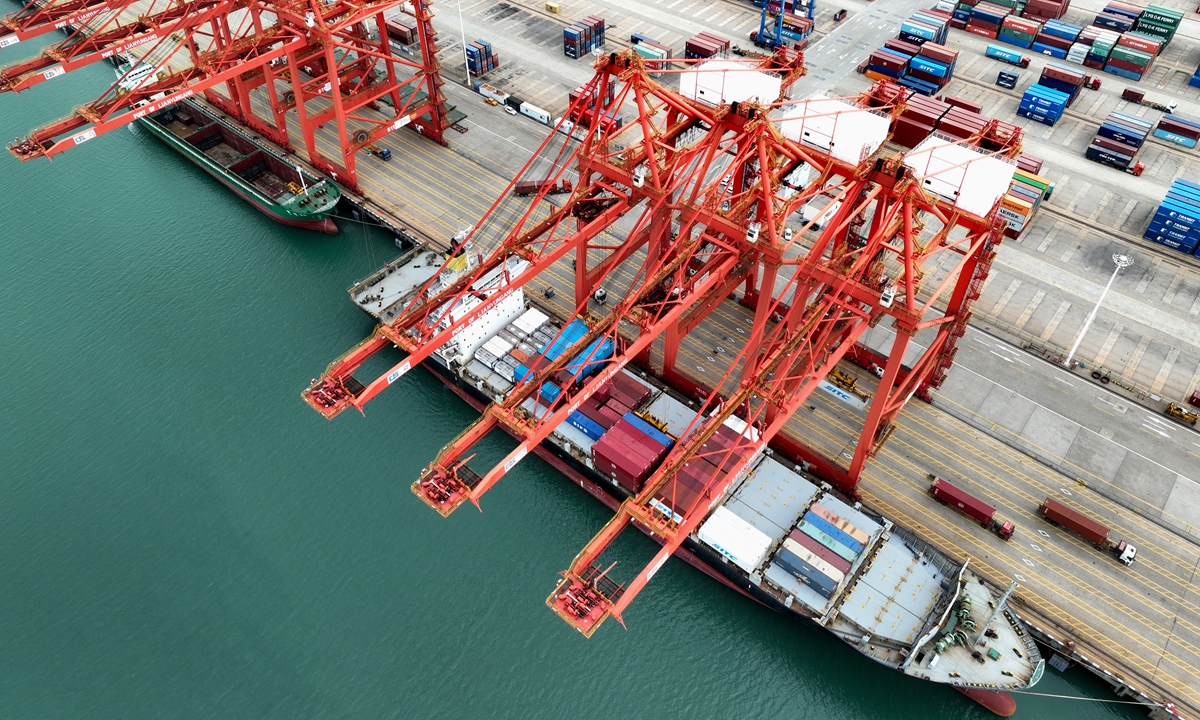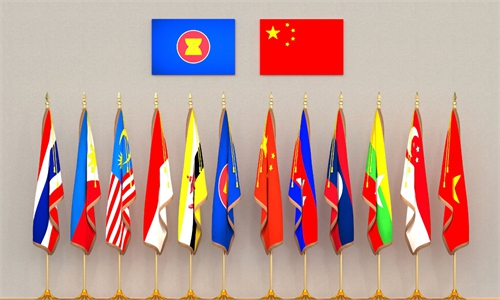China’s May exports drop 0.8% amid weak external demand; faster GDP growth expected

A cargo ship is berthed for loading and unloading containers at a terminal of the Port of Lianyungang in East China's Jiangsu Province on June 5, 2023. Photo: VCG
China's exports dropped by 0.8 percent year-on-year in May, due to weak external demand amid economic woes in major economies, while imports returned to growth during the month thanks to improving domestic demand, according to official data on Wednesday.
The fall in exports prompted foreign media hype about doubts on China's growth prospects. However, experts said that such a hype does not reflect the sustained recovery in China. Also, the World Bank has raised China's growth forecast for 2023, citing the recovery.
In May, China's total trade expanded by 0.5 percent year-on-year to 3.45 trillion yuan ($485 billion), with exports dropping 0.8 percent to 1.95 trillion yuan and imports growing 2.3 percent year-on-year to 1.5 trillion yuan, according to data from the General Administration of Customs (GAC).
The expansion in imports in May exceeded market expectations, bolstered by the steady domestic economic recovery, Zhou Maohua, an economist at Everbright Bank, told the Global Times on Wednesday.
Rising imports of upstream bulk commodities such as iron ore, crude oil, soybeans and other products reflected moves by domestic enterprises to restock in response to the gradual recovery of market demand, Zhou said.
The growth in imports in May reversed a 0.8 percent drop in April.
The contraction in exports growth was due in part to a high base during the same period last year, experts noted.
The base was significantly higher, which means lower year-on-year growth rates for exports this year, Wang Qing, chief macroeconomic analyst at Golden Credit Rating International, told the Global Times on Wednesday.
Still, weak demand overseas, particularly in advanced economies such as the US, may have played a major role behind the contraction in growth in May, according to experts.
In the first five months of 2023, exports to the US, which remained China's third-largest trading partner, fell 8.5 percent year-on-year. The EU remained the second-largest trading partner, with exports to the bloc growing 2.4 percent.
As external demand will remain weak, the focus for promoting an economic recovery will be on boosting internal consumption and investment, Wang said, adding that there will be more efforts to optimize and stabilize the trade structure.
In stark contrast to falling exports to some advanced economies, China's exports to ASEAN and countries and regions along the Belt and Road Initiative route grew 16.4 percent and 21.6 percent in the first five months, respectively, according to the GAC.
In total, from January to May, China's foreign trade expanded 4.7 percent year-on-year, reaching 16.77 trillion yuan, the GAC data showed. Exports rose by 8.1 percent year-on-year, while imports grew by 0.5 percent.
The GAC data also highlighted the crucial role of Chinese private enterprises in foreign trade. In the first five months, their total trade was up by 13.1 percent to 8.86 trillion yuan, accounting for 52.8 percent of total trade.
The data also reflected strong export momentum for China's mechanical and electrical products, which were up 9.5 percent to 5.57 trillion yuan. Vehicle exports totaled 266.78 billion yuan, up 124.1 percent.
China's vehicle exports in April were up 150 percent year-on-year to 425,000 units, data from the China Association of Automobile Manufacturers showed on Monday, with new-energy vehicles becoming a major component of vehicle exports.
Underscoring growing expectations for China's economic recovery, the World Bank on Tuesday further revised China's GDP growth forecast to 5.6 percent for 2023, up 1.3 percentage points from the previous estimate in January.
The World Bank noted that global activity is projected to slow with a pronounced deceleration in advanced economies and a sizable pick-up in China for 2023 as a whole. Growth is projected to rebound more quickly than previously expected in China, which reflects the economic reopening and supportive policy environment.
Amid China's bright prospects, experts said that while challenges linger, they remain confident for the upcoming quarters, with measures to support trade and domestic consumption further taking effect.
Pan Helin, joint director of the Research Center for Digital Economics and Financial Innovation affiliated with Zhejiang University's International Business School, projected stable trade in the second quarter and further improvement in the third quarter.
The General Office of the State Council, China's cabinet, has called for more efforts to further stabilize the nation's foreign trade and optimize its structure.
It targeted five aspects, including stepping up financial support and optimizing the trade development environment. It also called for efforts to continuously expand market and export scale for key products.

